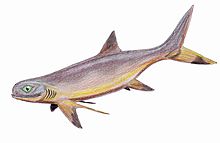| Symmorium Temporal range: Devonian-Carboniferous,
| |
|---|---|

| |
| Fossil specimen (FMNH PF 2202) of S. reniforme, Field Museum of Natural History | |

| |
| Life restoration of S. reniforme | |
| Scientific classification | |
| Domain: | Eukaryota |
| Kingdom: | Animalia |
| Phylum: | Chordata |
| Class: | Chondrichthyes |
| Order: | †Symmoriiformes |
| Family: | †Symmoriidae |
| Genus: | †Symmorium Cope, 1893 |
| Species: | †S. reniforme
|
| Binomial name | |
| †Symmorium reniforme Cope, 1893
| |

Symmorium is an extinct symmoriiform cartilaginous fish from the Devonian and Carboniferous of the United States (Illinois)[1][2] and Russia.[3] The type species, Symmorium reniforme, was named by Edward Drinker Cope in 1893,[4] with other species assigned to the genus having since been reclassified into other genera such as Petalodus. Symmorium bears close similarity in size and appearance to Stethacanthus[5] but lacks the "spine-brush complex" in place of the first dorsal fin.[6] Some paleontologists think that the two forms represented the males and females of related species, while other scientists think they were distinct genera.[6][7]
- ^ E. D. Cope. 1894. New and little known Paleozoic and Mesozoic fishes. Journal of the Academy of Natural Sciences Philadelphia (Series 2) 9:427-448
- ^ M. E. Williams. 1985. The "Cladodont level" sharks of the Pennsylvanian black shales of central North America. Palaeontographica Abteilung A 190:83-158
- ^ A. Ivanov. 1999. Late Devonian - Early Permian chondrichthyans of the Russian Arctic. Acta Palaeontologica Polonica 49(3):267-285
- ^ E. D. Cope. 1893. On Symmorium, and the position of cladodont sharks. American Naturalist 27:999-1001
- ^ "Hierarchical Taxonomy of the Class Chondrichthyes". comenius.susqu.edu. Archived from the original on 27 September 2007. Retrieved 12 January 2022.
- ^ a b M. Ginter, O. Hampe, and C. J. Duffin. 2010. Chondrichthyes, Paleozoic Elasmobranchii: Teeth. In H.P. Schultze (ed.), Handbook of Paleoichthyology 3D:1-168
- ^ Coates, Michael I.; Gess, Robert W.; Finarelli, John A.; Criswell, Katharine E.; Tietjen, Kristen (2017). "A symmoriiform chondrichthyan braincase and the origin of chimaeroid fishes". Nature. 541 (7636): 208–211. Bibcode:2017Natur.541..208C. doi:10.1038/nature20806. ISSN 0028-0836. PMID 28052054. S2CID 4455946.